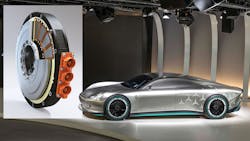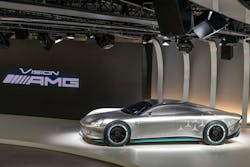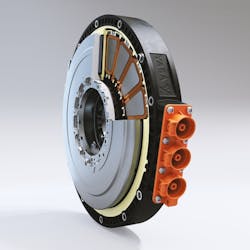The Lure of the Axial-Flux EV Motor
What you'll learn:
- Comparing the axial-flux motor with the radial-flux motor for EVs.
- Advantages of the "yokeless" axial-flux motor.
- Details of the YASA axial-flux motor topology.
If you find yourself wondering about an EV’s practicality, or bang-for-the-buck equation, or why more Americans should abandon internal combustion vehicles, stop. These are the wrong question to ask. The better question, the one automakers are asking themselves, is “What’s next?”
Mercedes-Benz and others believe it’s the axial-flux motor, revealed in M-B’s new Vision AMG (Fig. 1). The four-door electric coupe show car is currently being developed for the carmaker’s performance models, providing a preview of AMG’s all-electric future.
According to Philipp Schiemer, Chairman of the Management Board of Mercedes-AMG GmbH, “With this study, we are now offering a first glimpse of how we are transferring the AMG DNA into the all-electric future, starting in 2025.”
No Yoke
This harbinger of exciting things to come is powered by a new type of motor, a yokeless (it has no stator yoke) and segmented armature (YASA) topology that promises increased torque density, a shorter axial length, and high efficiency. It was developed for Mercedes by the company’s subsidiary YASA.
Permanent-magnet synchronous-motor (PMSM) design has been widely applied to date in electric vehicles due to its high power density and high efficiency. According to the direction of flux, PMSMs can be divided into categories: radial-flux motors and axial-flux motors. The main difference is that the magnetic flux travels parallel to the motor rotation axis in an axial motor, rather than perpendicularly in radial-flux motor designs. At present, radial-flux PMSMs have mostly been used on EVs with power densities in the range of 2.0 to 3.6 kW/kg.
For motors used in EV drive systems, the requirements are a large torque output in the low-speed area and a wide constant-power speed range in the high-speed area. EV makers such as Tesla rely on these radial electric motors, which can trace their history back 40 years or so.
Two main ways to increase the power density of the radial-flux PMSM are to improve the speed and reluctance torque (the torque experienced by a ferromagnetic object placed in an external magnetic field, which causes the object to line up with the external magnetic field). However, with the increase of motor speed, the problems of bearing life and motor noise become more prominent.
In comparison, the axial-flux PMSM, especially the yokeless and segmented armature axial-flux variety, exhibits advantages such as high torque density, short axial length, and higher efficiency.
Higher Density
The core advantage of an axial-flux motor is that the spinning rotor has a larger diameter, because it turns alongside the stator rather than inside it. This makes it more efficient and provides a higher power density. In addition, to overcome processing difficulties, the stator and rotors of the motor can be fabricated using soft magnetic composites.
The YASA topology is based around a series of magnetically separated segments that form the stator of the machine. The motor uses powdered iron materials that enable complex magnetic parts to be manufactured easily (Fig. 2). The iron in the stator of the YASA motor is dramatically lower when compared to other axial-flux motors, typically by 50%, leading to an overall increase in torque density of around 20%.
The energy density per kilogram of the motor is higher. Axial-flux motors can generate more torque, have fewer thermal-management issues, and use fewer materials, reducing overall weight and cost. Furthermore, this type of motor typically has suitable dimensions for packaging in, or close to, each of the vehicle wheels.
Different Topologies
Axial-flux machines appear in research literature in different topological forms due to a number of different flux path options, together with different winding and magnet configurations.
Two axial-flux permanent-magnet motors are being widely studied: a double-rotor single-stator yokeless and segmented armature structure, and a single-stator single-rotor configuration. Generally, the YASA configuration demonstrates higher efficiencies at higher speeds, while the single-stator, single-rotor is more efficient in high-torque duty cycles. The choice may prove to be application-specific with the preferred axial-flux motor topology, depending on the torque and speed driving cycle requirements.
At operating points with higher torque and lower speed, the single-sided machine exhibits a higher efficiency, while for higher speed and lower torque, the YASA design is more efficient. Also, YASA designs are lighter than their single-sided counterparts of comparable torque.
On the flip side, axial-flux motors have less surface area to evacuate heat than radial-flux motors. Consequently, direct-cooling YASA motors have been proposed with improved heat transfer efficiency, which increases the motor’s output power.
M-B claims that YASA’s axial-flux design increases power density by more than 30% and delivers a 5% range benefit over radial electric motors that typically power mass-market EVs. A repurposed Mercedes-Benz factory in Berlin will build axial-flux motors for the automaker’s AMG electric-only platform. The main challenge will be to adapt the various processes (assembly, production, welding, etc.) to this new technology.
M-B is not alone in looking at axial-flux motors. Renault has partnered with Whylot, of which it has acquired a 21% minority stake, to use axial-flux motors in its hybrids starting in 2025. The Whylot axial motor uses fewer magnets and has a smaller coil than a radial motor, resulting in a more compact and lighter engine. To help meet thermal challenges, a composite material rotor is employed.
Silicon-Carbon Anode Batteries
M-B also is planning for the next generation of cell chemistry to power its vehicles from mid-decade using silicon-carbon (SiC) composites in the anode to increase energy density, cut down charging times, and improve range.
While Mercedes hasn’t provided performance data or information on the battery’s energy content, we do know it will work with Sila, a battery materials company, to incorporate Sila’s silicon-anode lithium-ion chemistry in batteries, which will be optionally available for the first time in the upcoming electric Mercedes-Benz G-Class. Mercedes-Benz invested in Sila in 2019 as part of the company’s research and development of advanced batteries for the automaker's future electric vehicles.
The high-silicon anode material is said to increase the energy density of batteries without compromising safety or other performance parameters. Compared to today’s commercially available cells with a similar format, Sila claims its technology enables a 20% to 40% increase in energy density, reaching more than 800 Wh/l at cell level. This development will enable Mercedes-Benz to store more energy in the same space, thus increasing the range of its future vehicles by a substantive amount.
The silicon-anode materials will be manufactured using 100% renewable energy in Sila’s new Washington state facility,


